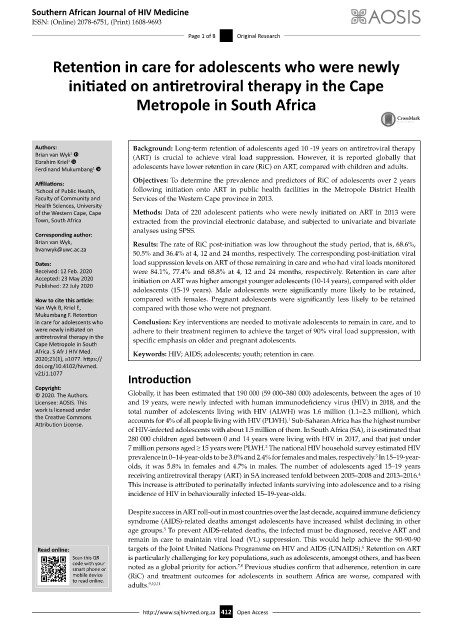Page 420 - HIVMED_v21_i1.indb
P. 420
Southern African Journal of HIV Medicine
ISSN: (Online) 2078-6751, (Print) 1608-9693
Page 1 of 8 Original Research
Retention in care for adolescents who were newly
initiated on antiretroviral therapy in the Cape
Metropole in South Africa
Authors: Background: Long-term retention of adolescents aged 10 -19 years on antiretroviral therapy
Brian van Wyk 1 (ART) is crucial to achieve viral load suppression. However, it is reported globally that
Ebrahim Kriel 1
Ferdinand Mukumbang adolescents have lower retention in care (RiC) on ART, compared with children and adults.
1
Objectives: To determine the prevalence and predictors of RiC of adolescents over 2 years
Affiliations:
1 School of Public Health, following initiation onto ART in public health facilities in the Metropole District Health
Faculty of Community and Services of the Western Cape province in 2013.
Health Sciences, University
of the Western Cape, Cape Methods: Data of 220 adolescent patients who were newly initiated on ART in 2013 were
Town, South Africa extracted from the provincial electronic database, and subjected to univariate and bivariate
analyses using SPSS.
Corresponding author:
Brian van Wyk, Results: The rate of RiC post-initiation was low throughout the study period, that is, 68.6%,
[email protected]
50.5% and 36.4% at 4, 12 and 24 months, respectively. The corresponding post-initiation viral
Dates: load suppression levels on ART of those remaining in care and who had viral loads monitored
Received: 12 Feb. 2020 were 84.1%, 77.4% and 68.8% at 4, 12 and 24 months, respectively. Retention in care after
Accepted: 23 May 2020 initiation on ART was higher amongst younger adolescents (10-14 years), compared with older
Published: 22 July 2020
adolescents (15-19 years). Male adolescents were significantly more likely to be retained,
How to cite this article: compared with females. Pregnant adolescents were significantly less likely to be retained
Van Wyk B, Kriel E, compared with those who were not pregnant.
Mukumbang F. Retention
in care for adolescents who Conclusion: Key interventions are needed to motivate adolescents to remain in care, and to
were newly initiated on adhere to their treatment regimen to achieve the target of 90% viral load suppression, with
antiretroviral therapy in the specific emphasis on older and pregnant adolescents.
Cape Metropole in South
Africa. S Afr J HIV Med. Keywords: HIV; AIDS; adolescents; youth; retention in care.
2020;21(1), a1077. https://
doi.org/10.4102/hivmed.
v21i1.1077
Introduction
Copyright:
© 2020. The Authors. Globally, it has been estimated that 190 000 (59 000–380 000) adolescents, between the ages of 10
Licensee: AOSIS. This and 19 years, were newly infected with human immunodeficiency virus (HIV) in 2018, and the
work is licensed under total number of adolescents living with HIV (ALWH) was 1.6 million (1.1–2.3 million), which
the Creative Commons accounts for 4% of all people living with HIV (PLWH). Sub-Saharan Africa has the highest number
1
Attribution License.
of HIV-infected adolescents with about 1.5 million of them. In South Africa (SA), it is estimated that
280 000 children aged between 0 and 14 years were living with HIV in 2017, and that just under
7 million persons aged ≥ 15 years were PLWH. The national HIV household survey estimated HIV
2
3
prevalence in 0–14-year-olds to be 3.0% and 2.4% for females and males, respectively. In 15–19-year-
olds, it was 5.8% in females and 4.7% in males. The number of adolescents aged 15–19 years
receiving antiretroviral therapy (ART) in SA increased tenfold between 2005–2008 and 2013–2016.
4
This increase is attributed to perinatally infected infants surviving into adolescence and to a rising
incidence of HIV in behaviourally infected 15–19-year-olds.
Despite success in ART roll-out in most countries over the last decade, acquired immune deficiency
syndrome (AIDS)-related deaths amongst adolescents have increased whilst declining in other
age groups. To prevent AIDS-related deaths, the infected must be diagnosed, receive ART and
5
remain in care to maintain viral load (VL) suppression. This would help achieve the 90-90-90
6
Read online: targets of the Joint United Nations Programme on HIV and AIDS (UNAIDS). Retention on ART
Read online:
Scan this QR
Scan this QR is particularly challenging for key populations, such as adolescents, amongst others, and has been
code with your
code with your 7,8
smart phone or noted as a global priority for action. Previous studies confirm that adherence, retention in care
smart phone or
mobile device (RiC) and treatment outcomes for adolescents in southern Africa are worse, compared with
mobile device
to read online.
to read online.
adults. 9,10,11
http://www.sajhivmed.org.za 412 Open Access

